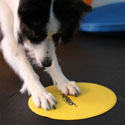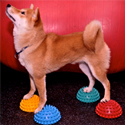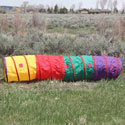Why? That is a question that most of us asked about many things when we were little. I never grew out of that. To this day, my mind generates why questions like a machine. Sporadically, I come up with a why question that keeps me stewing for months or years.
About a year ago my machine churned out, "Why does the click end the behavior?" That became, "does the click end the behavior?" I began taking inventory of my training and discovered that I was using the clicker as a marker, not as a signal to end the behavior. For example, I had taught my dogs to sit and down and to hold that position even if I clicked. I would then deliver the reward while they continued to sit or down. I was not allowing duration behaviors to end if I clicked.
At the same time I became frustrated with the method I had used to train my dogs to weave. I love to shape. Shaping is my preferred method of training; however, being honest with myself I had to acknowledge that parts of my training had holes in it. For example, two of my dogs had a problem with popping out of the poles while weaving.
For those of you not familiar with weave poles, they are an obstacle in dog agility. Dog agility is the canine version of an obstacle course. Cued by their handler, the dogs race over the course attempting to be both accurate and fast. For the dogs, the weave poles are generally considered the physically most demanding obstacle. Weave poles can also be challenging to train. The goal is to teach the dog to enter the weave poles to the right of the first pole. The goal then becomes to get the dog to negotiate the remaining poles as fast as possible.

A fast agility dog negotiates 12 poles in around 2 seconds. As part of competition, it is important that the dog complete all the poles. If the dog stops weaving and "pops" out of the poles, you must either fix the pop, asking the dog to enter where he popped, and complete the poles from there, or start again at the beginning. Either way, the popping has cost you precious time.
Both my dogs were popping out of the poles in competition. I evaluated the training methods I had used both in terms of how I was maintaining their weave pole performance, and how I had taught them to weave in the first place.
When I had shaped poles I was still thinking "the click ended the behavior." In training, what this meant was that if my dog had completed two poles when I clicked, he would be allowed to pop out of the poles and enjoy his reward without completing the remaining poles. At the end of the session I would put my dogs through the entire set a few times to make sure they understood that I wanted the entire set.
However, in competition, any sound either by me or by the audience would pop my dog Stevie out of the poles. I was puzzled. I know it probably seems obvious, but it wasn't to me. I couldn't figure out why he popped out when the only thing that popped him out in training was the clicker. I had forgotten about the fact that dogs generalize, and Stevie being a Border collie generalized very well. He had learned that a noise while weaving meant it was time for his reward. But that wasn't what I meant to train!
The truth began to settle into my mind. What happens when you click is incredibly important, but what happens after you click and BEFORE you reward is also incredibly important. If I click a dog for a sit, and as I fumble and reach for the treat, he also sniffs the ground, turns his head, and sneezes before I give him the treat. What I actually rewarded is the entire behavior chain. Next time I ask for sit, I may also get a sniff, head turn, and a sneeze.
I had taught my dog to pop, that was clear, but how was I going to fix it? Two conversations later, one with Karen Pryor and one with Kay Laurence, I had a plan. The click would no longer end the behavior when my dogs were weaving. I wanted the presence of the next pole to overshadow my click. If there is another pole, keep weaving and your reward will come at the end of the weaves.
My biggest concerns were whether I would be able to get my dogs to keep weaving even though for YEARS the click has ended the behavior, and if the reward always coming at the end of the poles would cause my dogs become slow at the beginning of the poles. This is called ratio strain in behavior terms. It means that the dog figures out that a reward is only coming at the end of a behavior chain, which may then cause the dog to be slow at the beginning of the chain and to only speed up at the end. From the dog's perspective, why rush at the beginning of the chain, where there is no hope of a reward?
I recruited help from my other instructors and students and we started off with the grand experiment. First my Border collie Nicki, I put her in the poles, I clicked, and immediately cued weave and prepared to reward at the end of the poles. Nicki entered the poles, visibly startled when I clicked and then dove thru the rest of the poles at top speed. When I reinforced her after the last poles the look in her eyes was as if to say, "Finally, I get to keep weaving, I have wanted to do that for years." I was happy; this was a good sign.
Stevie had a little more trouble making the transition, initially popping and having trouble reentering. But within about six attempts he had it and happily kept weaving after the click. I did use my body to help Stevie stay in the weaves and with in five sessions I had faded my body, being able to send, recall, or laterally handle at a distance while clicking him and he continued to weave.
The second concern about ratio strain also did not come to be. It seemed the dogs were perfectly happy knowing they were "right" and all consistently drove hard to get to the end of the poles regardless of where the click had sounded.
I do think that ratio strain would be a problem if the trainer only clicked and rewarded at the end. It seems that if you consistently vary where you click (at the third pole, then the next time at the seventh pole, and so on), ratio strain does not occur.
Okay, so the initial results were favorable, but these were Border collies and we needed other "subjects" that were less biddable and motivated.
Two weeks later, we had used the new method with young dogs learning to weave, and a wide variety of breeds. The jury was in, and it was looking good; the click-cue then reward experiment was a success.
So, if you are having trouble with duration behaviors, ask yourself why does the click have to end the behavior? The answer may hold the key to your training success.







Post new comment